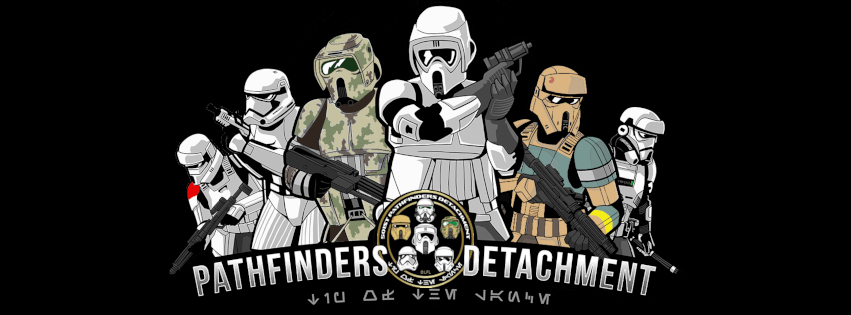-
Posts
1,925 -
Joined
-
Last visited
-
Days Won
135
Everything posted by Chef
-
Yeah, I'd be careful. Because that part of the chest plate has taken the most forming during production, there is always a certain amount of latent stress in that area and if you heat it up too much it is more likely to deform faster than another part of it. (not that it's not a tricky business to start with). So you can gently tease a bit more of a flare out of it, but you really risk deforming the whole curve on that end and that will really ruin your day. If you're not confident at it, I would say leave well alone at this stage. Get it strapped up and see how it all looks before doing any major 'surgery'.
-
I've got you over on the Garrison boards dude...
-
I've certainly not found any current 3D file that comes up to scratch... (I've looked... a lot) I've recently had this discussion with someone new to my Garrison, and having searched extensively, none of the current available files are what I would consider accurate enough for general clearance. That's not to say that if you did find a suitable file that was good enough in terms of screen accuracy it wouldn't be clearable.... But the end product would need to be judged. Fortunately with 3D files, it's simple enough to show us what the end result 'may' look like (depending on print etc...), so that judgement can be made quite easily before you go wasting rolls and rolls of filament.
-

Helmet Snout Greeblie - What color grey do we use?
Chef replied to haribon72's topic in ROTJ Biker Scout HQ
Primer grey seems to be most common. I think the originals were a bit 'lighter', but you won't go wrong with primer grey (which seems closest to your decals as well). -
As with all GRP (Fibreglass) buckets, the quality resides not on the external look of the thing, but the lay-up inside. If it is thin (say only a mm or two), then it will be brittle and subject to cracking/breaking. If it's too thick, then it will be hefty. As a laminator, I am always wary of GRP items and tend to look at how they are made more than 'what they look like'. Evidence of bubbles in the laminate or dry spots indicate a bad lay-up and something potentially riddled with constructional flaws. Yeah, it might be cheap, but with laminating, cheap doesn't tend to last all that long!
-
Most paints are naturally quite flexible, unless they are applied in a very thick layer, in which case they are susceptible to splitting. Using automotive paints, be they acrylics, cellulose or two-pack is always a good idea.
-
Yeah. Always use a separate primer. And make sure the primer is of the same type/manufacturer as the top coat. Paint is an incredibly fickle thing. Get the wrong ones and they'll react like a Gammorean with a toothache.
-
If you can find this or similar your side of the pond, it's awesome stuff. http://www.ebay.co.uk/itm/Plastic-Padding-Gelcoat-Filler-165g-Free-Gloves-Fibre-Glass-Repair-New-ZS97-/112198077770?hash=item1a1f86cd4a:g:RxIAAMXQ74JTRQVi Although to be honest, chips in the gelcoat can be repaired with more gelcoat!
-
Not to sh!tcan your claims of recasting... But achieving incredibly sharp detail with GRP (fibreglass) is just as equally possible as it is with resin. After all, GRP is just glass fibre strands encased in.... Resin! That's the one advantage of using GRP over vac forming. The detail that can be achieved is much sharper. As for his Scout lid... Difficult to say, it has very similar looking proportions and detail to an SC bucket. Interestingly, I would hazard that it's a recast of a vac-formed helmet because the detail is very weak, which is what you naturally get with vac forming (and subsequently taking a mould from the outside of it). Certainly in an around the ears with a back/cap style forming. With GRP, it's possible to eliminate all these, so why wouldn't you... Unless you don't want the 'work'. As an illustration, here is my very first version helmet, which was made in GRP. You get out, what you put in.
-
Welcome to the madhouse Bro!
-
Hey, I'm only going from the research that's out there... I'd have put it at Anthracite grey myself... But that's what has been said and I've no reason to contradict it, considering the source. Especially, as part of my 'leather-like' escapades, I have got samples of a very dark brown leatherette (don't ask why!). So it is possible. What I can say is that the lighting at CE3 was atrocious (I was there...) and going by any picture under those conditions is just a road to heartbreak central. Just as an illustrative point on colour and pictures.... Here's an example from my other major passion. The 'Aliens' Colonial Marine. These are the same colours believe it or not. And neither of them look like they do in the flesh (I have daily access to an original). So never trust a computer screen. But feel free to draw what ever conclusions you feel necessary, I've given all the information I know.
-
The neck seal is brown (as confirmed by someone who wore the costume on the film set), and is part of the whole upper vest. It's not a separate part.
-
Whilst that's all very nice and detailed.... it's not an accurate representation of the film one. As Cheyenne has said, it's very much like the Kenner one, which is incorrect over so many parts, so it's difficult where to start.
-
It all depends on what gel coat was used as the base. If it's brilliant white, it should match the armour quite well. If not, then it won't. It's just a question of paint codes, exactly the same as if it was paint. If you can't buff/polish/weather it to blend in then you're going to need to paint it. Appliance white (a fairly standard colour around the globe) is a good match for most plastic sheets.
-
Yup, mine is attached via velcro to the bottom of the flak vest.
-
There is a bit of a discussion ongoing about this at the moment Phil. The current specs states 25mm for the lower one (which will go through that slot), but there is some speculation about whether its closer to 20mm for the strap. I've get to get some decent enough pictures that will allow me to scale the straps and get a better idea of what it is. I think in the one above, it's pulled tight, which naturally makes it thinner. So I don't think it is as small as 12-15mm. Could it be 20... possibly. We'll keep you updated, but at the moment the specs state 25mm.
-
My armour is HIPS and it's been going for years with no ill effects... But then it is 3mm. I'm a complete dork in mine as I am sure any of the UKG chaps will confirm! HIPS has more 'impact' resistance than ABS (the clue is in the name), but is far more prone to cracking under torsional load (flexing and twisting). HIPS is also less likely to 'yellow' over time, unless you have the acrylic caps ABS, which is UV resistant. Now Scout armour doesn't tend to come under much torsional stress, certainly a lot less than compared to TK armour, so doesn't tend to suffer the cracking that you get with a TK made out of the same material. The only area that is likely to suffer is the belt, and then only if you keep flexing it to put it on and off (which shouldn't be necessary). It isn't all that much cheaper than ABS, so people shouldn't really use that as a justification (3mm HIPS costs practically the same as 2mm ABS). Helmets made in HIPS shouldn't be a problem... They don't suffer any stresses as a such, so you shouldn't be worried by this. Material thickness is always a factor with HIPS, so the thicker the better. I wouldn't trust anything less than 2mm in HIPS, 2.5mm or 3mm for preference, and that is purely because of the mechanical properties of it. The thicker it is, the more resistance to torsional stress, therefore the less likely to crack. If you can see through it... I would avoid it on principle, as that can't be good. The reason a lot of people don't use it is because it is hygroscopic and absorbs water. So unless you have a drying facility, when it is formed the water boils in the plastic and 'pops' holes in the surface and ruins the sheet. HIPS doesn't do this. Obviously, this isn't an issue for 'formed' stuff, because you are unlikely to try and heat it up this much again... TK Lids were originally made out of HDPE, which is another beast again.... In short, thick HIPS is no better or worse than ABS. It's just 'different'. Certainly where Scouts are concerned. I would never use it for a TK which has to inherently have more 'flex' in the suit.
-
The fixing method is largely immaterial as long as it looks like it should. Most people tend to use the rivet to secure the belt in place because it's there, so why not. Plus remember the main belt plastic section also does take the weight of the straps and drop boxes too, to making sure it is nice and secure is a consideration. If you do have size fluctuation, you can also make the belt larger around the back and add in more velcro to allow for this. I usually put in about a 10cm overlap on the belt, which allows for about 4" of discrepancy. This can obviously be tailored to suit. When you think about it... the plastic bit doesn't get any bigger/smaller, even when you do, so the points where the rivets are won't be changing anyway. It's only the 'join' at the back that will change. So you're probably not to make any difference by attaching it with velcro or using the rivets anyway!
-
Any other pictures of the rest of it so we can try and identify which armour set it is?? That's a new one on me!
-
Well, I think the difference between 1.5" (38mm) and 40mm is largely immaterial to be honest. Having measured my '40mm' webbing which I get over here, it's actually 38mm anyway. So fear not.
-
I've got rolls of it dude... (pure white, not off white though). If you need a length I can stick some in the post for you.
-
Yup, as above... Just weather them with some dirt. Rub it in over the stitching and you won't notice it. Or claim it's Ewok blood.
-
Yeah, it's all there somewhere.... Just not in one handy place. If you're unsure about anything just ask in the mean time.
-
We're in the process of sorting out all the 'reference' stuff at the moment... Or at least collating it all. There is plenty of it floating around on here already, it's just not all nice and neat in one place. Straps wise. That extra gap will not be a negative for your application. It'll be hardly noticeable, as it equates to about 2-3mm overall.
-
yeah, it is there, we just went a fraction too long on the cover strip. it's under that. The upwards stitch under the dog bone goes all the way up to where the laces are.


